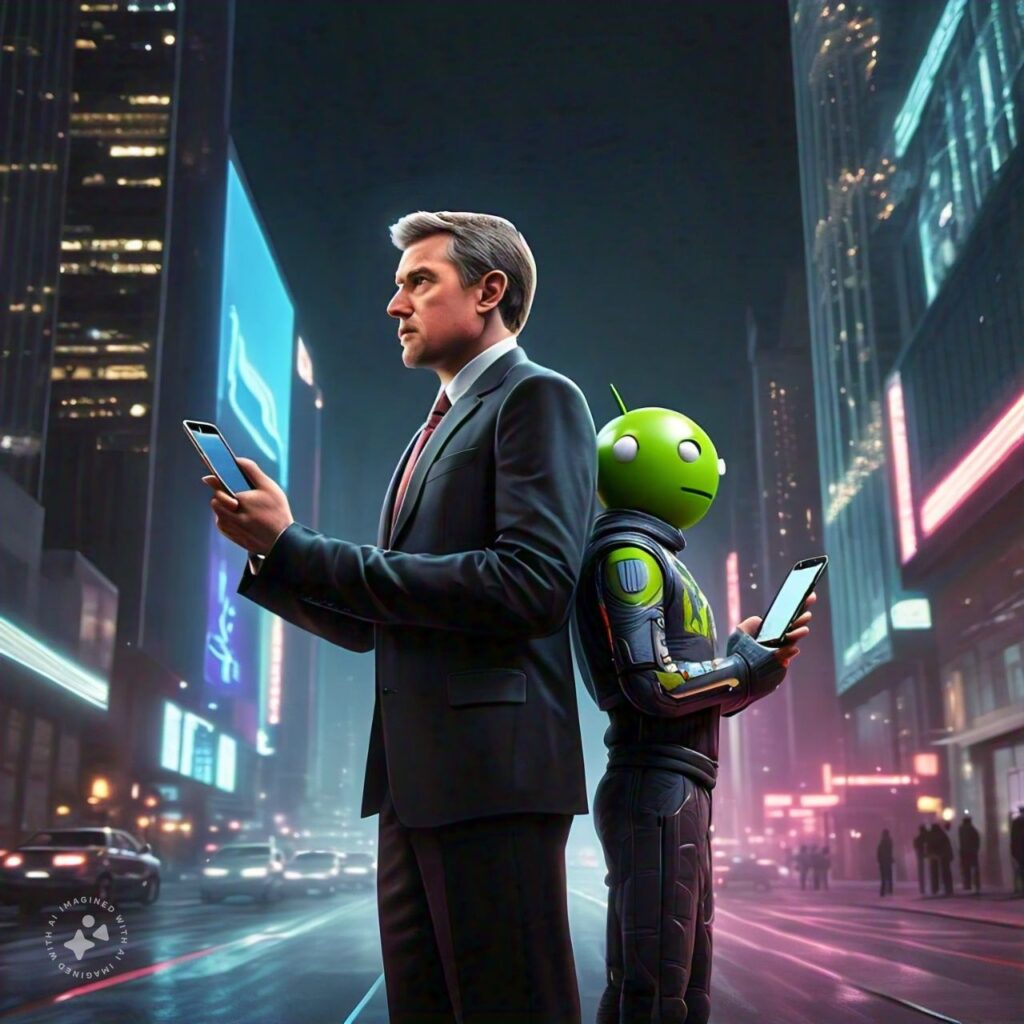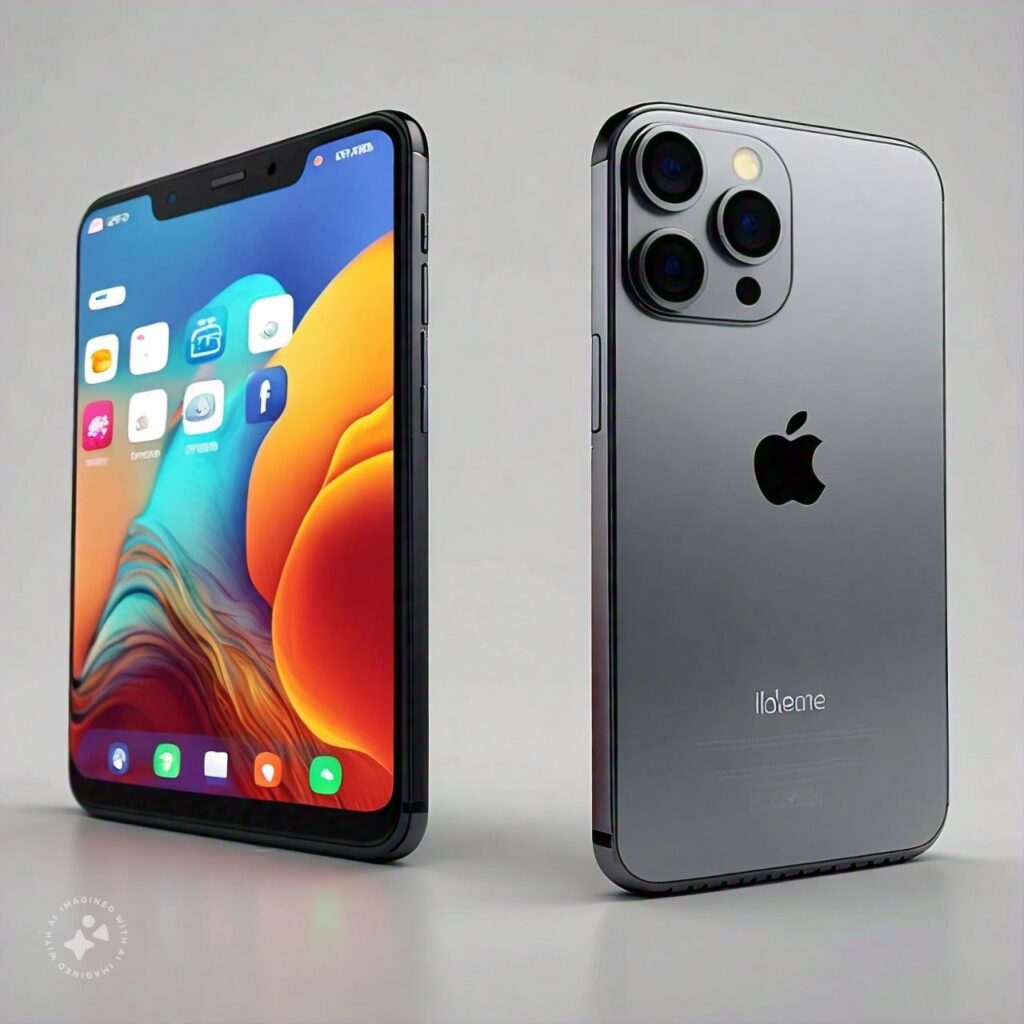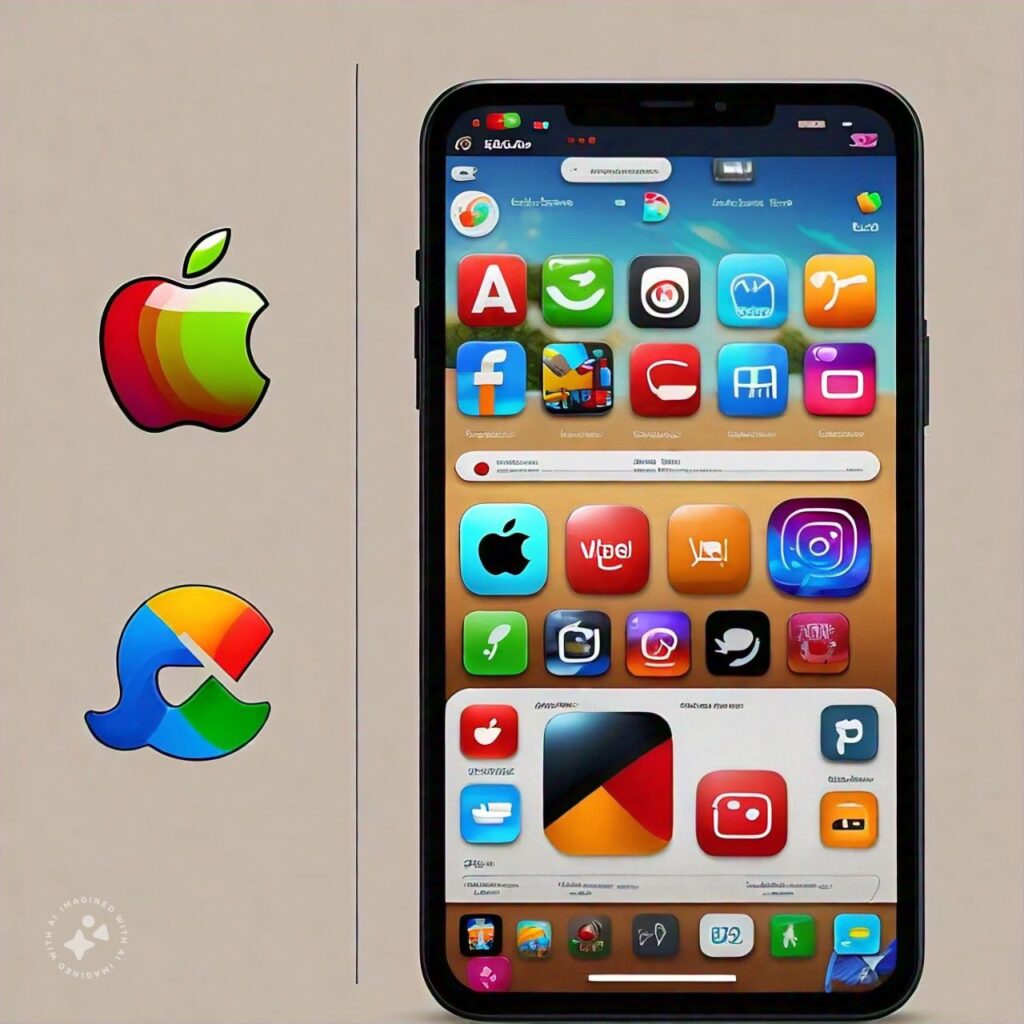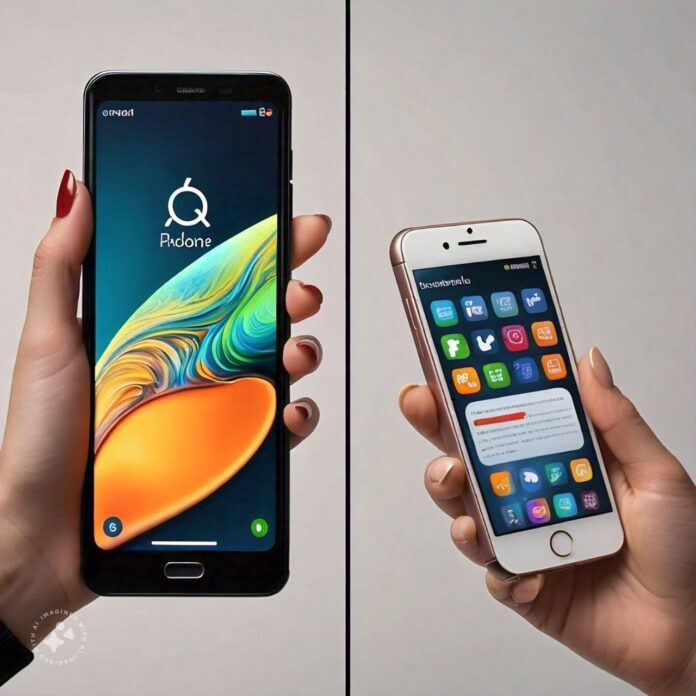Introduction
For over ten years, the debate between iPhone and Android users has been a hot topic, with both sides passionately defending their choice. Whether you’re a tech enthusiast or just someone who uses a smartphone daily, you’ve probably heard arguments about which platform is better. In this article, we’ll break down the key differences between iPhone and Android, covering everything from hardware and software to user experience, apps, and security. By the end, you’ll have a better idea of the pros and cons of each, making it easier to choose the one that’s right for you.
Operating System Overview
| IOS (Apple Inc.) | Android (Google Inc.) |
| Latest Version: IOS 18 (2024) | Latest version : Android 15 (2024) |
| Market share :30-35% globally | Market share :70% globally |
| Active Devices: Over 1.5 billion active iOS devices | Active Devices: Over 3 billion active Android devices worldwide. |
History and Background
1.1 The Birth of the iPhone
The iPhone, created by Apple Inc., was first introduced by Steve Jobs in 2007. It changed the smartphone world by combining a mobile phone, an iPod, and an internet communication device into one sleek gadget. The iPhone’s success was due to its stylish design, easy-to-use interface, and the launch of the App Store, which opened up endless opportunities for both developers and users.
1.2 The Rise of Android
Android started as a project by Android Inc., which was later bought by Google in 2005. The first Android device, the HTC Dream (also known as the T-Mobile G1), was released in 2008. Unlike the iPhone’s closed system, Android was an open-source platform, allowing manufacturers to tailor the software to their needs. This flexibility led to a wide range of Android devices across different price points, making it the most popular mobile operating system in the world.

2. Hardware Design and Build Quality
2.1 iPhone’s Premium Design
Apple has built a strong reputation for its high-end hardware design and top-notch build quality. The iPhone is made with premium materials like glass and aluminum, giving it a sleek, luxurious look and feel. With each new model, Apple continues to refine the iPhone’s design, paying close attention to every detail. This careful craftsmanship, combined with the seamless integration of hardware and software, ensures that the iPhone not only looks great but also performs smoothly and lasts a long time.
2.2 Android’s Diversity in Design
Android, as an open-source platform, is used by many different manufacturers, each bringing their own design ideas to the table. This results in a wide variety of Android devices with different styles, build materials, and price points. Whether you’re looking for a budget-friendly plastic phone or a premium glass-and-metal smartphone, Android has something for everyone. However, this variety also means that build quality can vary, with some manufacturers focusing more on cost than on craftsmanship.

3. Operating System and User Interface
3.1 iOS: A Smooth and Simple Experience
The iPhone uses iOS, Apple’s operating system designed specifically for their devices. iOS is known for being easy to use, with a consistent look and feel across all Apple products. Because Apple controls both the hardware and software, iOS runs smoothly with minimal issues. Updates are rolled out regularly to all compatible devices at the same time, ensuring that everyone gets the latest features and security improvements.
3.2 Android: Flexible and Customizable
Android, developed by Google, offers a more flexible experience that allows users to customize their devices to their liking. You can change almost everything about how your device looks and works, including the home screen layout and which apps are used by default. Android also allows for widgets, which give you quick access to information and controls right on your home screen. However, this flexibility can sometimes lead to inconsistencies, as different devices might run different versions of Android, which can affect performance and available features.
4. App Ecosystem
4.1 App Store vs Google Play
When it comes to smartphone apps, the iPhone’s App Store and Android’s Google Play Store are the two main places where you can download them.
iPhone App Store
The App Store is known for its strict rules about which apps can be listed. This means you get a more polished selection of apps, with fewer that are low-quality or potentially harmful. Because iPhone users are more likely to spend money on apps, developers often focus on iOS when launching new apps.
Google Play Store
The Google Play Store, on the other hand, has a more relaxed approach to app submissions. This allows for a wider variety of apps, including experimental or niche ones. However, this openness can also lead to more low-quality or problematic apps. Additionally, since Android devices come in many shapes and sizes, developers have to make sure their apps work well across different devices and versions, which can sometimes affect app performance.

5. Performance and Speed
5.1 iPhone’s Optimization
Apple’s ability to control both the hardware and software of its devices means that iPhones are often very smooth and responsive. Even though iPhones generally have less RAM than many Android devices, they still perform exceptionally well. This is largely thanks to Apple’s custom-designed A-series chips, which enhance speed and efficiency. Because the hardware and software are so closely integrated, iPhones load apps quickly, handle multitasking effortlessly, and display smooth animations.
5.2 Android’s Raw Power
Many flagship Android phones from brands like Samsung, Google, and OnePlus come with high-end hardware, including large amounts of RAM and powerful processors. This means they can handle demanding tasks, such as gaming or video editing, very well. However, because the Android ecosystem is so diverse, performance can vary widely between different devices. While high-end models offer great performance, some budget Android phones may struggle with more demanding apps.
6. Battery Life and Charging
6.1 iPhone’s Battery Efficiency
Apple works hard to improve battery life with each new iPhone model. They design their hardware and software to help the iPhone use its battery efficiently, even though the battery sizes are often smaller. Features like Low Power Mode are available to help extend battery life when needed. However, iPhones have usually been slower at charging compared to some Android phones, though newer models have started to charge faster.
6.2 Android’s Battery Options
Android phones come in many different models, which means there’s a wide range of battery sizes and charging speeds. Many high-end Android phones have large batteries and support fast charging, wireless charging, and even charging other devices wirelessly. Some Android phones also have customizable battery-saving modes. But because there are so many different Android devices, battery life can vary a lot, with some cheaper models struggling to last all day on one charge.
7. Camera Quality
7.1 iPhone’s Consistency
The iPhone is famous for its camera quality, especially how well it works in different lighting conditions. Apple’s camera software is designed to take natural-looking photos with true-to-life colors and great detail. The iPhone also does an excellent job with video recording, offering features like 4K video at 60fps and a cinematic mode for high-quality videos.
7.2 Android’s Versatility
Android phones, especially high-end models, often come with multiple cameras for different types of shots, like wide-angle and zoom. Brands like Google, Samsung, and Huawei have pushed the limits of smartphone photography with advanced technology. However, the quality of Android cameras can vary a lot between different models, with some budget phones having lower-quality cameras compared to the high-end ones.
8. Software Updates
8.1 iPhone’s Uniform Updates
One of the iPhone’s biggest advantages is its consistent and timely software updates. Apple supports its devices with updates for many years, often longer than any Android manufacturer. This ensures that even older iPhone models receive the latest features and security patches, contributing to the device’s longevity and resale value.
8.2 Android’s Fragmentation
Android’s open nature and the diversity of manufacturers lead to a more fragmented update process. While Google’s Pixel devices receive timely updates, other manufacturers may delay updates due to the need to customize the software for their devices. This fragmentation means that many Android users may not receive the latest OS updates or security patches, potentially leaving their devices vulnerable to security risks.
9. Ecosystem Integration
9.1 iPhone’s Ecosystem
The iPhone shines with its smooth integration with other Apple devices and services. When you use an iPhone, you get a unified experience with your iPad, Mac, Apple Watch, and Apple TV. Features like Handoff and AirDrop make it easy to switch between devices, share files, and even take calls on your Mac or iPad. iCloud keeps everything in sync across all your Apple devices.
9.2 Android’s Flexibility
Android is all about flexibility, working with a variety of devices from different brands. Google’s ecosystem, including services like Google Drive, Google Photos, and Google Assistant, offers a connected experience for users who use Google’s tools. Android also works well with other platforms, such as Windows and smart home gadgets, giving you more options for device compatibility.
10. Customization and Personalization
10.1 iPhone’s Simplicity
The iPhone is designed to be simple and user-friendly, with a focus on ease of use. While Apple has added some customization features over time, like widgets and app icon changes, it generally offers a more straightforward experience compared to Android. This simplicity is perfect for users who prefer a consistent, easy-to-navigate interface without needing to customize much.
10.2 Android’s Customization Options
Android stands out for its wide range of customization possibilities. Users can change almost everything about their device, from the home screen layout and icons to widgets and launchers. This level of personalization is great for tech enthusiasts who love tweaking their phones to fit their personal style. However, the sheer number of options can be a bit overwhelming for some users.
11. Price and Affordability
11.1 iPhone’s High Prices
Apple markets the iPhone as a high-end product, so it comes with a higher price tag. iPhones usually cost more than most Android phones, especially the latest models. Although Apple does offer older iPhones at lower prices, they are still seen as a luxury choice, which might not be affordable for everyone.
11.2 Android’s Many Choices
Android phones come in a wide range of prices, from budget-friendly to high-end. This variety means that Android phones are accessible to many people, regardless of their budget. Brands like Xiaomi, OnePlus, and Motorola offer well-made Android phones at lower prices, making them a good option for those looking to save money.
12. Customer Support and Warranty
12.1 Apple’s Customer Support
Apple is well-regarded for its customer support. You can visit an Apple Store and get help with your device at the Genius Bar, where experts can fix issues and offer technical assistance. AppleCare+ provides extra coverage for accidental damage and extends the warranty, giving you more security. Plus, iPhones tend to hold their value well, making it easier to upgrade to a new model.
12.2 Android’s Manufacturer Support
Support for Android devices can differ based on the brand. High-end models from companies like Samsung and Google usually come with strong support options, including in-store repairs and extended warranties. However, support for cheaper Android phones might not be as good, with shorter warranties and fewer repair choices. This inconsistency can be a downside for some users.
13. Accessibility Features
13.1 iPhone’s Accessibility
Apple focuses a lot on accessibility with features like VoiceOver (which reads out what’s on the screen), AssistiveTouch (which helps with touch gestures), and hearing aid compatibility. These features help people with disabilities use iPhones easily. Apple also keeps updating these features to make sure everyone can use their devices comfortably.
13.2 Android’s Customizable Accessibility
Android phones offer various accessibility features too, such as TalkBack (which reads screen content), magnification gestures (for zooming in), and customizable text and display settings. Android’s flexibility allows users to add third-party accessibility apps and adjust their phones to better suit their needs. However, these features might differ depending on the phone model and the manufacturer’s custom software.
14. Wearables and Accessories
14.1 iPhone and Apple Watch
The Apple Watch is the most popular smartwatch in the world. It works really well with the iPhone and has lots of health and fitness features. Apple also offers other accessories like AirPods, which provide high-quality sound and features like spatial audio and easy switching between devices. The iPhone works with many accessories from both Apple and other companies, making it very versatile.
14.2 Android and Wear OS
Android has a wide range of wearables, including smartwatches with Google’s Wear OS and fitness trackers from brands like Fitbit and Garmin. Wear OS smartwatches work well with Google services and have various apps, but they don’t have the same smooth experience as the Apple Watch. Since Android is open to many manufacturers, you’ll find lots of accessories, but their quality and compatibility can vary.
Conclusion
Choosing between an iPhone and an Android phone can be tough because both have their own good and bad points. The iPhone is great for people who like a smooth, high-quality experience with strong security and privacy features. It’s a good choice if you want things to be simple and work well together.
Android phones offer more flexibility and options, with many different devices and prices. This makes it a good pick for people who want more choices and innovation.
In the end, it’s up to you and what you need. Whether you go for the iPhone’s sleek experience or Android’s variety, both are powerful tools that can make your digital life better.
